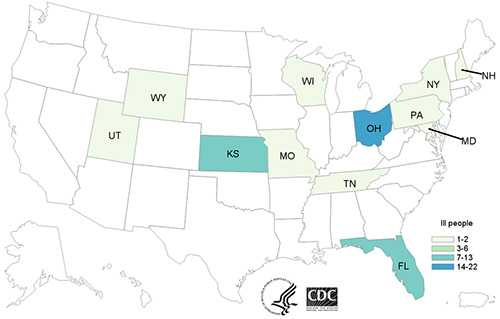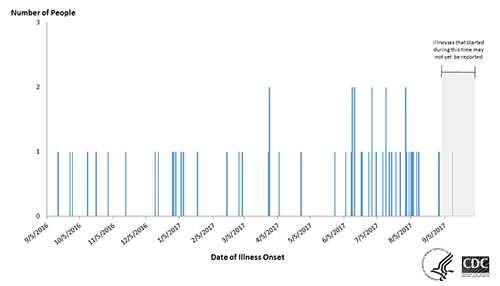Multistate Outbreak of Multidrug-Resistant Campylobacter Infections Linked to Contact with Pet Store Puppies
Posted October 3, 2017 2:00 PM ET
Outbreak Advisory
55
Cases
12
States
13
Hospitalizations
0
Deaths
- Read Advice to Pet Owners and Advice to Pet Store Workers.
- Read Advice to Clinicians and Advice to Veterinarians.
- The Ohio Department of Health, several other states, the Centers for Disease Control and Prevention (CDC), and the U.S. Department of Agriculture Animal and Plant Health Inspection Service (USDA-APHIS) are investigating a multistate outbreak of human Campylobacter infections linked to puppies sold through Petland, a national pet store chain.
- 16 more ill people with a Campylobacter infection linked to the outbreak have been reported since September 11, 2017. The most recent illness began on September 12, 2017.
- As of October 3, a total of 55 people with laboratory-confirmed infections or symptoms consistent with Campylobacter infection who live in 12 states (Florida, Kansas, Maryland, Missouri, New Hampshire, New York, Ohio, Pennsylvania, Tennessee, Utah, Wisconsin, and Wyoming) have been linked to this outbreak.
- 14 people are Petland employees from 5 states.
- 35 people either recently purchased a puppy at Petland, visited a Petland, or visited or live in a home with a puppy sold through Petland before illness began.
- 1 person had sexual contact with a person with a confirmed illness linked to Petland.
- 4 people were exposed to puppies from various sources.
- 1 person had unknown puppy exposure.
- Ill people range in age from <1 year to 86 years, with a median age of 23 years; 38 (69%) are female; and 13 (24%) report being hospitalized. No deaths have been reported.
- Epidemiologic and laboratory evidence indicates that puppies sold through Petland stores are a likely source of this outbreak. Petland is cooperating with public health and animal health officials to address this outbreak.
- Whole genome sequencing showed samples of Campylobacter isolated from the stool of puppies sold through Petland were closely related to Campylobacter samples isolated from the stool of ill people in multiple states.
- Clinical samples from people and puppies sickened in this outbreak appear to be resistant to commonly recommended, first-line antibiotics. This means infections with the outbreak strain may not respond well to oral antibiotics usually prescribed to treat Campylobacter infections.
- CDC’s National Antimicrobial Resistance Monitoring System (NARMS) team analyzed whole genome sequence data from Campylobacter isolated from stools of seven ill people and six ill puppies to look for genes that predict antibiotic resistance.
- Analysis suggests that all 13 isolates are resistant to azithromycin, ciprofloxacin, clindamycin, erythromycin, nalidixic acid, and telithromycin. In addition, 9 isolates appear resistant to gentamicin, and 12 isolates appear resistant to tetracycline.
- Typically, predicted antibiotic resistance using whole genome sequence data matches the results of traditional antibiotic resistance testing for Campylobacter.*
- NARMS performed traditional antibiotic resistance testing on one isolate from an ill person. It showed resistance to the same antibiotics that analysis of whole genome sequence data predicted: azithromycin, ciprofloxacin, clindamycin, erythromycin, gentamicin, nalidixic acid, telithromycin, and tetracycline.
- CDC’s National Antimicrobial Resistance Monitoring System (NARMS) team analyzed whole genome sequence data from Campylobacter isolated from stools of seven ill people and six ill puppies to look for genes that predict antibiotic resistance.
- Campylobacter can spread through contact with dog poop (feces). It usually does not spread from one person to another, however, activities such as changing an infected person’s diapers or sexual contact with an infected person can lead to infection.
- Regardless of where they are from, any puppies and dogs may carry Campylobacter germs. Read Advice to Pet Owners and Advice to Pet Store Workers for illness prevention tips.
- This investigation is ongoing. CDC will provide updates as more information becomes available.
* Zhao, S., Tyson, G.H., Chen, Y., Li, C., Mukherjee, S., Young, S., et al. (2015). Whole genome sequencing accurately predicts antimicrobial resistance phenotypes in Campylobacter species. Appl Environ Microbiol, 82(2), 459 – 466.
Previous Outbreak Advisories
Initial Announcement
September 11, 2017
The Ohio Department of Health, several other states, CDC, and USDA-APHIS are investigating a multistate outbreak of human Campylobacter infections linked to puppies sold through Petland stores. Investigators are looking for the source of infections in people and puppies so they can recommend how to stop the outbreak and prevent more illnesses in order to protect human and animal health.
As of September 11, 2017, the outbreak includes 39 cases in 7 states (Florida, Kansas, Missouri, Ohio, Pennsylvania, Tennessee, and Wisconsin). A list of the number of cases by state can be found on the Case Count Map page.
Illnesses began on dates ranging from September 15, 2016 through August 12, 2017. The most recent illness was reported on September 1, 2017.
Ill people range in age from <1 year to 64 years, with a median age of 22 years; 28 (72%) are female; and 9 (23%) report being hospitalized. No deaths have been reported.
Epidemiologic and laboratory findings have linked the outbreak to contact with puppies sold through Petland stores. Among the 39 ill people, 12 are Petland employees from 4 states and 27 either recently purchased a puppy at Petland, visited a Petland, or visited or live in a home with a puppy sold through Petland before illness began.
Whole genome sequencing showed samples of Campylobacter isolated from the stool of puppies sold through Petland in Florida were closely related to Campylobacter isolated from the stool of an ill person in Ohio. Additional laboratory results from people and dogs are pending.
Regardless of where they are from, any puppies and dogs may carry Campylobacter germs. Read Advice to Pet Owners and Advice to Pet Store Workers for illness prevention tips.
Advice
Advice to Pet Owners
The bond between people and their pets can increase fitness, lower stress, and bring happiness to their owners. But pets, including puppies and dogs, sometimes carry germs that can make people sick. One of the diseases people can get from puppies and dogs is Campylobacter infection. Most infections affect one person at a time and are not part of a recognized outbreak.
Know the symptoms of a Campylobacter infection and what to do if you have a serious infection:
- Most people with a Campylobacter infection develop symptoms 2 to 5 days after being exposed to the bacteria. Symptoms usually last about a week. The following are typical symptoms:
- Diarrhea (that is often bloody)
- Fever
- Stomach cramps
- Nausea
- Vomiting
- People more likely to get a severe infection include:
- People with weakened immune systems (such as people with the genetic blood disorder thalassemia or HIV or people receiving chemotherapy)
- Children younger than 5 years
- Adults 65 years and older
- Pregnant women
Follow these steps when choosing a puppy or dog:
- Pick a puppy or dog that is bright, alert, and playful. Puppies and dogs should have shiny, soft fur that is free of poop (feces).
- Take your new puppy or dog to the veterinarian for a health check-up within a few days to a week after adoption.
- More information on choosing and caring for a puppy or dog is available here.
Follow these steps if your puppy or dog is ill:
- Contact your veterinarian. Signs of illness include appearing sluggish, not eating, diarrhea, and abnormal breathing. Keep in mind that even a dog that appears healthy might spread germs to people and other animals.
- If your puppy or dog becomes sick or dies soon after purchase or adoption, take it to the veterinarian promptly, and inform the pet store, breeder, or rescue organization about your dog’s illness or death.
- Thoroughly clean the area occupied by your ill pet. If your puppy died, consider waiting at least a few weeks before purchasing or adopting another pet to reduce the chance of spreading disease to your new pet.
Follow these steps to prevent the spreading of disease between people and puppies and dogs:
-
Wash your hands thoroughly with running water and soap for at least 20 seconds every time you touch dogs, their food, or clean up after them. Adults should supervise handwashing for young children.
- If soap and water are not readily available, use hand sanitizer until you are able to wash your hands with soap and water.
- Pick up and dispose of dog poop, especially in areas where children might play. Use disposable gloves and wash your hands thoroughly afterwards.
- Clean up any pee (urine), poop (stool), or vomit in the house immediately, and disinfect the area. Use disposable gloves to handle anything that has touched pee, poop, or vomit, and wash your hands thoroughly afterwards.
- Take your dog to the veterinarian regularly to keep it healthy and to help prevent the spread of disease.
- Don’t let pets lick around your mouth and face.
- Don’t let pets lick your open wound or areas with broken skin.
Advice to Pet Store Workers
Puppies and dogs sometimes carry germs that can make people sick. One of the most common diseases people can get from puppies and dogs is Campylobacter infection.
Know the symptoms of a Campylobacter infection and what to do if you have a severe infection.
- Most people with a Campylobacter infection develop symptoms 2 to 5 days after being exposed to the bacteria. Symptoms usually last about a week. The following are typical symptoms:
- Diarrhea (that is often bloody)
- Fever
- Stomach cramps
- Nausea
- Vomiting
- People more likely to get a severe infection include:
- People with weakened immune systems (such as people with the genetic blood disorder thalassemia or HIV or people receiving chemotherapy)
- Children younger than 5 years
- Adults 65 years and older
- Pregnant women
Wash your hands.
-
Wash your hands thoroughly with running water and soap for at least 20 seconds during these times:
- Before and after eating
- After using the toilet
- After touching pets and other animals
- After touching pet food and treats or food and water containers
- After cleaning up pee (urine), poop (feces), or vomit
- After touching raw food of animal origin
- Dry hands using a clean paper towel or air-dry them. Do not dry hands on clothing.
Eat and store your food safely.
- Always eat and drink in designated break areas away from places where animals roam or are caged and exercised.
- Keep food for people away from areas where pet food and treats are stored, and where animals roam or are caged or exercised.
Play it safe with animals and their food.
- Wash your hands thoroughly with soap and water right after handling any pet food, including live or frozen rodents, raw meat, wet or dry food, and after touching feed and water containers.
- Don’t let pets lick around your mouth and face.
- Don’t let pets lick any of your open wounds or areas with broken skin.
Clean up messes safely.
- Clean up any pee, poop, or vomit in the store immediately, and disinfect the area well.
- Use disposable gloves for clean-ups, and wash your hands thoroughly afterwards.
- Wash work shoes or boots, gloves, clothes, and equipment regularly.
Follow store protocols for identifying and reporting sick or injured animals.
Advice to Clinicians
- Clinical samples from people and puppies sickened in this outbreak suggest antibiotic resistance to commonly recommended, first-line antibiotics. That means infections with the outbreak strain may not respond well to oral antibiotics (e.g., fluoroquinolones, macrolides) usually prescribed to treat Campylobacter infections.
- CDC’s analysis of Campylobacter isolates from stools of 7 ill people and 6 ill puppies suggests that all 13 isolates are resistant to azithromycin, ciprofloxacin, clindamycin, erythromycin, nalidixic acid, and telithromycin.
- In addition, isolates from 6 people and 3 puppies appear resistant to gentamicin, and 12 isolates appear resistant to tetracycline.
Clinicians should consider the following when managing patients who are suspected to be infected with the outbreak strain (for example, a patient with exposure to an ill puppy from a pet store):
- Supportive care (e.g., rehydration, electrolyte repletion) is sufficient for most patients.
- For patients who may require antibiotics (e.g., those who are at high risk for serious illness, such as infants and young children, adults aged 65 and older, pregnant women, and people with compromised immunity):
- Stool culture and antimicrobial susceptibility testing should be ordered for suspected outbreak-associated cases.
- Antibiotic choice should be tailored to the individual patient’s antimicrobial susceptibility testing results as soon as possible.
- Consider consulting an infectious disease specialist for choosing therapy.
- When empiric treatment is required, agents to which the outbreak strain is resistant should be avoided (agents to avoid include those listed above as well as penicillins, cephalosporins, and trimethoprim-sulfamethoxazole to which all C. jejuni infections are inherently resistant).
- Inquiries related to antibiotic resistance associated with this outbreak can be directed to CDC at EntericBacteria@cdc.gov.
Advice to Veterinarians
- Regardless of where they come from, any puppy or dog can carry, get sick from, and shed Campylobacter. The same is true for certain other pets, including kittens and cats, ferrets, rodents, and other small mammals.
- Talk to pet owners about taking simple steps to prevent getting sick from their puppies or dogs:
- Wash hands thoroughly with running water and soap for at least 20 seconds every time you touch dogs, their food, or clean up after them.
- Pick up and dispose of dog poop, especially in areas where children might play. Use disposable gloves and wash your hands thoroughly afterwards.
- Clean up any pee (urine), poop (stool), or vomit in the house immediately, and disinfect the area. Use disposable gloves to handle anything that has touched pee, poop, or vomit, and wash your hands thoroughly afterwards.
- Don’t let pets lick mouths, faces, open wounds, or areas with broken skin.
- Take your dog to the veterinarian regularly to keep it healthy and to help prevent the spread of disease.
Dog Testing
- Dogs under 12 months of age or any puppy or dog adopted from crowded environments or from pet stores and showing signs of Campylobacter infection, including bloody mucoid diarrhea, should receive a gram-stained fecal smear to identify Campylobacter-like organisms.
- Laboratory confirmation of Campylobacter infection can be made from a fecal sample transported in Cary-Blair medium, or a quantitative-PCR from a fresh stool sample, in consultation with a veterinary diagnostic lab.
- Puppies and dogs with Campylobacter infection should be isolated to prevent the spread of infection. Campylobacter infections are often self-limiting and supportive care is frequently the only treatment needed.
- If Campylobacter infection is confirmed with laboratory testing and the puppy or dog has hemorrhagic diarrhea, or a fever, and antibiotic treatment is warranted, the choice of antibiotic should be guided by culture and sensitivity results. The antibiotic resistance profile for this outbreak includes the commonly used antibiotics (e.g., fluoroquinolones, macrolides). Because Campylobacter jejuni has inherent antibiotic resistance to other commonly prescribed oral antibiotics (e.g., penicillins, cephalosporins, trimethoprim-sulfamethoxazole), infections with the outbreak strain may be difficult to treat with oral antibiotics.
Environmental Sanitation
- Thoroughly clean surfaces and equipment that have been in contact with stool from any dog suspected to have a Campylobacter infection with water and detergent to remove any organic material. An EPA-registered disinfectant should subsequently be used according to label instructions to disinfect the surface or equipment.
- For additional information on proper disinfection procedures, visit www.nasphv.org/Documents/VeterinaryStandardPrecautions [PDF – 27 pages].
- Page last reviewed: September 6, 2017
- Page last updated: October 5, 2017
- Content source:


 ShareCompartir
ShareCompartir


